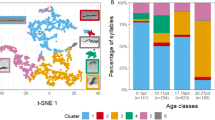Abstract
Infant babbling in humans and a few other primates plays an important role in allowing the young to practice the adult vocal repertoire during early behavioral development. Vocalizations uttered during babbling resemble, to some degree, the acoustic structure of adult vocalizations and are often produced in long bouts independent of any social context. Similar behavior, termed subsong or plastic song, is known from a variety of songbirds. Here, we show that pups of the sac-winged bat (Saccopteryx bilineata), a species with an unusually large vocal repertoire, produce renditions of all known adult vocalization types during bouts of vocalizations, which appear to be independent of a distinct social context. Babbling occurs in pups of both sexes, even though only adult males, not females, utter all different vocalization types produced in infancy. To our knowledge, this is the first evidence of babbling in a nonprimate mammal and suggests that infant babbling may be necessary for the ontogeny of complex vocal repertoires.



Similar content being viewed by others
References
Behr O, von Helversen O (2004) Bat serenades—complex courtship songs in the sac-winged bat (Saccopteryx bilineata). Behav Ecol Sociobiol 56:106–115
Bradbury JW, Emmons L (1974) Social organization of some Trinidad bats. I. Emballonuridae. Z Tierpsychol 36:137–183
Bradbury JW, Vehrencamp SL (1976) Social organization and foraging in Emballonurid bats. I. Field studies. Behav Ecol Sociobiol 1:337–381
Catchpole CK, Slater PJB (1995) Birdsong: biological themes and variations. Cambridge University Press, Cambridge, UK
Doupe AJ, Kuhl PK (1999) Birdsong and human speech: common themes and mechanisms. Annu Rev Neurosci 22:567–631
Elowson AM, Snowdon CT, Lazaro-Perea C (1998a) Babbling and social context in infant monkeys: parallels to human infants. Trends Cogn Sci 2:31–37
Elowson AM, Snowdon CT, Lazaro-Perea C (1998b) Infant ‘babbling’ in a nonhuman primate: complex vocal sequences with repeated call types. Behaviour 135:643–664
Emlen ST, Oring LW (1977) Ecology, sexual selection and the evolution of mating systems. Science 197:215–223
Goldstein MH, King AP, West MJ (2003) Social interaction shapes babbling: testing parallels between birdsong and speech. Proc Nat Acad Sci USA 100(13):8030–8035
Heckel G, von Helversen O (2003) Genetic mating systems and the significance of harem associations in the bat Saccopteryx bilineata. Mol Ecol 12:219–227
Heckel G, Voigt CC, Mayer F, von Helversen O (1999) Extraharem paternity in the white-lined bat Saccopteryx bilineata (Emballonuridae). Behaviour 136:1173–1185
Hultsch H, Todt D (2004) Learning to sing. In: Marler P, Slabbekorn H (eds) Nature’s music: the Science of birdsong. Elsevier Academic, London, pp 80–107
Marler P, Peters S (1982) Subsong and plastic song: their role in the vocal learning process. In: Kroodsma DE, Miller EH (eds) Acoustic communication in birds, vol. 2: song learning and its consequences. Elsevier Academic, London, p 25–50
Omedes A (1985) Infantile calls of the silvery marmosets (Callithrix argentata melanura) during the first 10 weeks. Misc Zool 9:412–418
Snowdon CT, Elowson AM (2001) Babbling in pygmy marmosets: development after infancy. Behaviour 138:1235–1248
Tannenbaum BR (1975) Reproductive strategies in the white-lined bat. Ph.D. thesis, Cornell University
Werker JF, Tees RC (1999) Influences on infant speech processing: toward a new synthesis. Annu Rev Psychol 50:509–535
Wilkinson GS (2003) Social and vocal complexity in bats. In: de Waal FBM, Tyack PL (eds) Animal social complexity. Harvard University Press, Cambridge, MA, p 322–341
Winter M, Rothe H (1979) Darstellung des Lautrepertoires handaufgezogener Weissbüscheläffchen (Callithrix j. jacchus) unter besonderer Berücksichtigung der fließenden Übergänge zwischen den einzelnen Lautgruppen. Primates 20:259–276
Acknowledgements
We want to thank Martina Nagy for participating in field data acquisition. Mark Bee, Thomas Friedl, Marc Holderied, Georg Klump, Ulrike Langemann, Frieder Mayer, and Christian Voigt made most helpful comments during discussions on the topic and the manuscript. We also want to thank Marc Holderied, Nic Kontratieff, Wolfram Schulze, Stefan Schuster, and Frieder Mayer for technical support and helpful suggestions. La Selva Biological Station and the Organization for Tropical Studies (OTS) provided sophisticated infrastructure for fieldwork. We also thank the Costa Rican authorities, especially Javier Guevara and the Parque Nacional Braulio Carillo, for support and research permissions. This study was supported by the University of Erlangen. All fieldwork complied with the current laws of Costa Rica.
Author information
Authors and Affiliations
Corresponding author
Rights and permissions
About this article
Cite this article
Knörnschild, M., Behr, O. & von Helversen, O. Babbling behavior in the sac-winged bat (Saccopteryx bilineata). Naturwissenschaften 93, 451–454 (2006). https://doi.org/10.1007/s00114-006-0127-9
Received:
Accepted:
Published:
Issue Date:
DOI: https://doi.org/10.1007/s00114-006-0127-9




